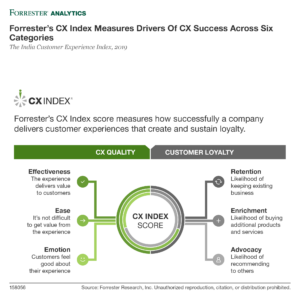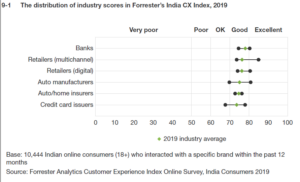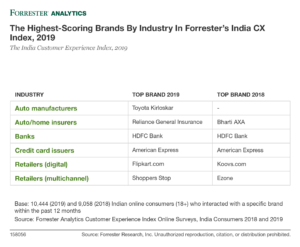What Does CX Look Like In India?
It’s that time of the year again when we publish results from our annual Customer Experience Index (CX Index™) survey to benchmark the customer experience provided by major brands in India.
For those who came in late, here’s a quick introduction to the methodology: The survey is based on Forrester’s CX Index framework, which is designed to measure how successfully a brand delivers CX that creates and sustains loyalty. Forrester’s CX Index was launched back in 2007, and each year we use the framework to dive deep into the CX of over 600 brands in 17 industries across the globe, quizzing over 200,000 customers in the process.

In India, we’ve been running this for five years now. In 2019, we covered six industries in the subcontinent: auto/home insurers, auto manufacturers, banks, credit card issuers, digital retailers, and multichannel retailers. Within these industries, we surveyed over 10,000 customers of 39 brands to understand and quantify the experience these brands offered them.
So what did we find? How did the CX of different industries, on average, stack up? Which brands shone strong? And more importantly, why?
CX Excellence Makes A Comeback
Turns out, 2019 was a fantastic year for CX in the country. This year:
- On average, banks delivered the best CX compared to other industries.
- Each industry’s average CX score went up.
- Twenty-four of 39 brands increased scores year on year; no brand dropped scores.
- Thirty-three of 39 brands delivered good CX.
- Amazingly, four brands delivered excellent CX — this included Shoppers Stop, HDFC Bank, Flipkart.com, and Toyota Kirloskar.

Industry-wise, top brands included:

Other highlights from our 2019 India results include:
- Shoppers Stop received the highest score across industries.
- HDFC Bank topped banks for the second year in a row.
- American Express topped credit card issuers for the third time in a row.
- The biggest score jumps came from Shoppers Stop and State Bank of India, both going up over 15 points each.
- Better customer service continues to be a key challenge for many brands.
Consistency Separated The Leaders From The Rest
A quick analysis of the winners in each industry revealed two common threads:
- Each of those brands was able to deliver excellent experiences to a far higher number of their customers than their peers. This implied stronger processes, enabling these brands to deliver consistently well across touchpoints. This makes logical sense; the big thing most brands struggle with is scale — how do they scale excellence? This is a problem that these CX leaders seem to have cracked.
- Leaders had a stronger focus on understanding customer needs, becoming customer-centric, adopting design best practices, and improving the culture . . . all key ingredients needed to sustainably improve CX. We know this is true anecdotally, as well, from different surveys that point to the same things. Plus, many of these firms have been doubling down on digital for some time now — for example, all major banks have refreshed or renewed their mobile apps recently and continue to become smarter and more mature with what they’re doing in the digital space. The fruits are finally starting to appear.
Lack Of Differentiation Is A Looming Problem
While many brands improved their scores this year, a key problem persists: Over 70% of brands in the list are what we call “locksteppers” — moving up/down together in a herd. This means the quality of their CX remains roughly on par with that of their competitors. Also indicative of this problem is the bunching up of brand scores, especially for banks and auto/home insurers; the top few brands in both these industries were barely separated from each other. Going forward, only brands that can differentiate themselves will reap the benefits of better CX — AKA, more loyal customers.
Emotion Holds The Key To Achieving CX Leadership
Brands that want to break away from the pack should focus on emotion: How an experience makes customers feel has a bigger influence on their loyalty to a brand than effectiveness or ease in nearly every industry. Brand performance in the India CX Index, 2019 reflects this: The top three brands provided an average of 84 emotionally positive experiences for each negative experience; the lowest-performing three brands provided only 19 emotionally positive experiences for each negative experience.
What does this mean for brands? For starters, they need to figure out what their best and worst customers are saying about them. They also need to determine which emotions and drivers influence loyalty for their customers and which ones hurt them most — all of which a framework like the CX Index can help with.
The full report, with some additional data points, is available here. In 2019, what does the CX of your brand look like?
If you have questions or comments, please feel free to leave comments below.
